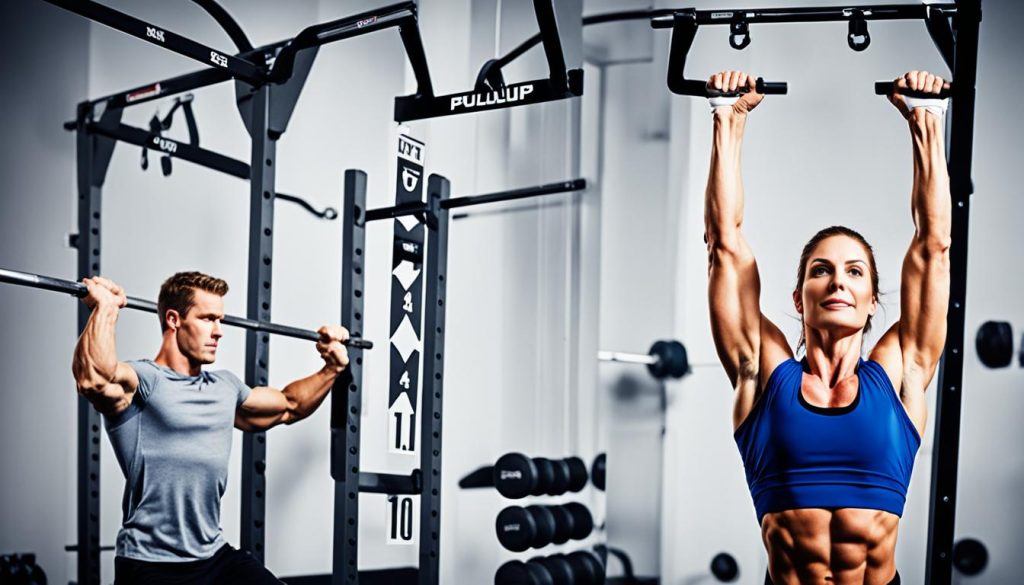Pull ups are a challenging yet effective bodyweight exercise that many people strive to master. However, there is no one-size-fits-all answer to the question of how many pull ups you should be able to do. Factors such as age, sex, and fitness level can all play a role in determining an individual’s optimal number of pull ups.
In this guide, we will explore the benchmarks, standards, and average pull up counts for different groups to help you assess your own pull up strength and set realistic goals.
Whether you’re a beginner or an experienced fitness enthusiast, understanding pull up standards and setting pull up goals can help you track your progress and work towards improving your pull up performance. So, let’s dive in and find out how many pull ups you should be able to do to reach your fitness goals!
How to Perform a Pull Up?
Before we discuss how to perform a pull up, let’s understand the proper form and technique for this exercise. Pull ups are a challenging upper body exercise that primarily target the back muscles. By mastering the proper pull up technique, you can maximize your results and minimize the risk of injury. Here’s a step-by-step guide to performing a pull up with proper form:
- Grip: Start by gripping an overhead bar with a pronated grip, palms facing away from you. Ensure that your hands are slightly wider than shoulder-width apart.
- Position: Hang from the bar, fully extending your arms and keeping your feet off the ground. Engage your core muscles to maintain stability throughout the exercise.
- Initiate the pull: Begin the exercise by using your back muscles to pull your body up towards the bar. Keep your elbows pointing down and back, and avoid using momentum or swinging.
- Reach the top position: Continue pulling until your chin or chest reaches the bar. Squeeze your shoulder blades together at the top to fully engage your back muscles.
- Controlled descent: Lower your body back down to the starting position in a controlled manner, fully extending your arms and maintaining tension in your back muscles.
- Repeat: Perform the desired number of repetitions or follow a structured pull up workout program.
Remember to breathe evenly throughout the exercise and avoid using excessive momentum. Focus on engaging your back muscles and maintaining proper form to reap the benefits of this challenging exercise.
If you’re new to pull ups or find them difficult, you can start by using an assisted pull up machine or resistance bands to gradually build strength. Progressively decrease the amount of assistance or resistance as you get stronger.
To visualize the proper form for a pull up, take a look at the image below:

Benefits of Pull Ups
Pull ups offer numerous advantages that make them an essential exercise to include in your fitness routine. By engaging a variety of muscles in your upper body, pull ups provide a comprehensive workout with a range of benefits for your overall strength and physical fitness.
Targeted Muscles
Pull ups primarily target the back muscles, including the latissimus dorsi, rhomboids, and trapezius. These muscles play a crucial role in posture, upper body stability, and overall strength. The pulling motion of the exercise also engages the chest, shoulders, forearms, and core muscles, providing a comprehensive upper body workout.
Improved Muscular Strength
One of the key benefits of pull ups is their ability to improve overall muscular strength. By consistently performing pull ups and gradually increasing the difficulty level, you can strengthen your back, arms, and shoulders, leading to increased functional strength and endurance.
Increased Grip Strength
Pull ups are an excellent exercise for enhancing grip strength. As you grip the bar and pull your bodyweight up, the forearm muscles, particularly the flexor muscles responsible for grip, are activated and strengthened. Improved grip strength can have a positive impact on various activities, such as weightlifting, rock climbing, and everyday tasks.
Enhanced Upper Body Aesthetics
In addition to their functional benefits, pull ups also contribute to enhanced upper body aesthetics. Regularly performing pull ups can help sculpt and define muscles in your back, arms, and shoulders, leading to a more toned and attractive physique.
Promotes Better Body Composition
Pull ups are a compound exercise that engages multiple muscle groups simultaneously, leading to a higher calorie burn and increased heart rate. This calorie-burning effect can contribute to better body composition by reducing body fat and improving muscle definition.
Improved Posture
Strengthening the back muscles through pull ups can have a positive impact on your posture. A strong back helps maintain proper spinal alignment and reduces the risk of developing poor posture-related issues, such as rounded shoulders or a hunched back.
Functional Strength and Overall Fitness
By incorporating pull ups into your workouts, you can improve your overall functional strength and fitness level. Having a strong upper body and improved muscular endurance can enhance your performance in various activities and daily tasks, such as lifting heavy objects, carrying groceries, or participating in sports.
To reap the full benefits of pull ups, it is important to incorporate them into a well-rounded workout routine that includes a variety of exercises targeting different muscle groups. Whether you are a beginner or an experienced fitness enthusiast, pull ups can be adapted to suit your fitness level and goals, making them a valuable addition to any workout program.
| Benefits | Summary |
|---|---|
| Targets back muscles | Latissimus dorsi, rhomboids, and trapezius |
| Improves muscular strength | Strengthens back, arms, and shoulders |
| Increases grip strength | Targets forearm flexor muscles |
| Enhances upper body aesthetics | Tones and defines back, arms, and shoulders |
| Promotes better body composition | Burns calories and improves muscle definition |
| Improves posture | Maintains spinal alignment and reduces postural issues |
| Enhances functional strength and overall fitness | Improves performance in daily tasks and activities |
How Many Pull Ups Should I Be Able to Do?
The optimal number of pull ups a person should be able to do depends on various factors, including age, sex, and fitness level. While there are no universally accepted standards for pull ups, some benchmarks can provide guidance.
Fit and active men should aim for at least 4 to 8 pull ups in one set, while fit and active women should aim for at least 1 to 3 pull ups in one set. However, these numbers can vary significantly based on individual factors.
It is important to set realistic goals and work towards improving your pull up performance over time. To help you assess your progress and target specific fitness levels, refer to the following table:
| Fitness Level | Males | Females |
|---|---|---|
| Beginner | 0-2 pull ups | 0 pull ups |
| Novice | 3-4 pull ups | 1 pull up |
| Intermediate | 5-8 pull ups | 2-3 pull ups |
| Advanced | 9-12+ pull ups | 4-6+ pull ups |
Remember that these are general guidelines, and individual progress may vary. Don’t be discouraged if you’re not at the desired fitness level right away. Consistency, proper form, and gradual progression are key to improving your pull up performance.

By gradually increasing the number of pull ups you can do, you’ll challenge your muscles, improve your strength, and achieve your fitness goals. Stay motivated, be consistent, and celebrate your progress along the way!
Average Pull Ups by Age and Sex
Pull up performance can vary based on age and sex. For children, the number of pull ups they can do tends to increase with age for boys, while it remains relatively consistent and then declines for girls after puberty. Adults generally reach their peak strength in their late 20s or early 30s, and the number of pull ups they should be able to do can vary based on individual factors. Fitness norms for youth athletes provide some standards for pull up performance by age and sex, but these are not universal guidelines for adults.
Below is a table showing average pull up counts for different age groups and sexes:
| Age Range | Average Pull Ups for Boys | Average Pull Ups for Girls | |
|---|---|---|---|
| Children | 6-8 years | 2-5 | 2-4 |
| 9-13 years | 3-8 | 1-3 | |
| Teens | 14-17 years | 5-10 | 1-3 |
| 18-20 years | 6-11 | 1-3 | |
| 21-29 years | 6-12 | 1-3 | |
| 30+ years | 4-10 | 1-2 |

Pull Up Goals and Standards
Setting pull up goals is an effective way to improve your pull up performance and track your progress. While there are no official standards for pull ups in adults, you can use certain benchmarks as reference points. Two common benchmarks are the Navy SEALS test and the Presidential Physical Fitness Award standards.
The Navy SEALS test requires a minimum of 10 pull ups in two minutes. This test is used by the elite Navy SEALs to assess upper body strength and endurance. Achieving this goal can be challenging and requires consistent training and dedication.
The Presidential Physical Fitness Award sets various standards for pull ups based on age and percentile rankings. This award recognizes excellence in physical fitness in school-aged children. While these standards are specific to youth, they can serve as a useful reference for adults as well.
However, it’s important to remember that pull up goals should be personalized and focused on individual improvement rather than comparing yourself to others. Every person has unique strengths and abilities, and progress should be measured against your own starting point.
Pull Up Goals and Standards
| Test/Standard | Minimum Pull Ups | Time Frame |
|---|---|---|
| Navy SEALS Test | 10 | 2 minutes |
| Presidential Physical Fitness Award | Varies by age and percentile rankings | N/A |
As you work on improving your pull up performance, set realistic and achievable goals that push you to become stronger and more capable. Focus on proper form, gradually increase your repetitions, and consistently incorporate pull ups into your training routine. Celebrate each milestone you reach along the way, and enjoy the journey of becoming a master of the pull up exercise.

Conclusion
Pull ups are an incredible exercise that can greatly enhance your upper body strength and overall fitness. However, the number of pull ups you should be able to do depends on various factors, such as your age, sex, and fitness level. It’s important to set realistic goals and focus on improving your pull up strength over time.
To achieve pull up goals, it is crucial to maintain proper form and technique, train consistently, and gradually increase your strength. By doing so, you can steadily improve your pull up performance and enhance your overall fitness level. Remember to listen to your body, track your progress, and celebrate every milestone along your journey.
Assessing your pull up performance is a personal journey, and comparing yourself to others may not always be helpful. Instead, focus on personal improvement and continue challenging yourself. With dedication and perseverance, you can improve your pull up strength, achieve your goals, and unlock new levels of strength and fitness.




